| Line 41: | Line 41: | ||
[[Paleontology|Paleontologists]] have classified ''Carcharodontosaurus'' in its own family, the Carcharodontosauridae. Being the type genus, ''Carcharodontosaurus'' is obviously typical of the family. Its fossils consist mostly of fragmentary skulls. Reconstruction is based on ''Carcharodontosaurus''' close relative, [[Giganotosaurus|''Giganotosaurus'']]. Both massive theropods are carcharodontosaurids, in the allosaur group. Like ''Giganotosaurus'', ''Carcharodontosaurus ''had a lightweight, porous skull with large fenestrae. It would have been a powerful hunter, with long front arms equipped with hook-like claws, and narrow jaws with teeth much like those of the [http://en.wikipedia.org/wiki/Great_White_Shark great white shark]. It would have been graceful, and elegant in design. Like many allosauroids, it also had a ridge above each of its eyes. |
[[Paleontology|Paleontologists]] have classified ''Carcharodontosaurus'' in its own family, the Carcharodontosauridae. Being the type genus, ''Carcharodontosaurus'' is obviously typical of the family. Its fossils consist mostly of fragmentary skulls. Reconstruction is based on ''Carcharodontosaurus''' close relative, [[Giganotosaurus|''Giganotosaurus'']]. Both massive theropods are carcharodontosaurids, in the allosaur group. Like ''Giganotosaurus'', ''Carcharodontosaurus ''had a lightweight, porous skull with large fenestrae. It would have been a powerful hunter, with long front arms equipped with hook-like claws, and narrow jaws with teeth much like those of the [http://en.wikipedia.org/wiki/Great_White_Shark great white shark]. It would have been graceful, and elegant in design. Like many allosauroids, it also had a ridge above each of its eyes. |
||
| − | [[File:Largest Theropods 2.1.png|thumb|300px|left|A scale chart showing ''C. iguidensis'' alongside other giant theropods, ''C. iguidensis'' in yellow.]]Although poorly known, ''Carcharodontosaurus ''was most likely the second-largest predatory dinosaur ever, after [[Spinosaurus|''Spinosaurus'']]. ''C. sahiricus'' measured between 12 and 12.8 meters long and weighed in at around 5 to 6 tonnes. However, the larger ''C.iguidennis'' measured up to 14m long and weighed nearly 7t. Ever since its discovery it has been a contender for the title of largest Theropod. Its initial indetification led to massive hype, despite ''Tyrannosaurus'' was of a similar length but bulkier, and the seemingly forgotten ''[[Spinosaurus]]'' was bigger still at 14-15m at the time. ''Carcharodontosaurus'' fell out of the public view until Paul Sereno discovered some more fossils in the 1990's. But it was still largely ignored due to the ''[[Tyrannosaurus|Tyrannosaurus Rex]]'' 'Sue' and ''[[Giganotosaurus]]'', despite the fact that ''Carcharodontosaurus'' was likely longer than ''Tyrannosaurus'' and ''Giganotosaurus''. I twas not until ''C. iguidensis'' was described in 2007 that it was recognised as truly larger than ''Tyrannosaurus''. |
+ | [[File:Largest Theropods 2.1.png|thumb|300px|left|A scale chart showing ''C. iguidensis'' alongside other giant theropods, ''C. iguidensis'' in yellow.]]Although poorly known, ''Carcharodontosaurus ''was most likely the second-largest predatory dinosaur ever, after [[Spinosaurus|''Spinosaurus'']]. ''C. sahiricus'' measured between 12 and 12.8 meters long and weighed in at around 5 to 6 tonnes. However, the larger ''C.iguidennis'' measured up to 14m long and weighed nearly 7t. Ever since its discovery it has been a contender for the title of largest Theropod. Its initial indetification led to massive hype, despite ''Tyrannosaurus'' was of a similar length but bulkier, and the seemingly forgotten ''[[Spinosaurus]]'' was bigger still at 14-15m at the time. ''Carcharodontosaurus'' fell out of the public view until Paul Sereno discovered some more fossils in the 1990's. But it was still largely ignored due to the ''[[Tyrannosaurus|Tyrannosaurus Rex]]'' 'Sue' and ''[[Giganotosaurus]]'', despite the fact that ''Carcharodontosaurus'' was likely longer than ''Tyrannosaurus'' and comparable in size with ''Giganotosaurus''. I twas not until ''C. iguidensis'' was described in 2007 that it was originally recognised as truly larger than ''Tyrannosaurus'' but after it was discovered that it was a bit smaller. |
==Species == |
==Species == |
||
Revision as of 13:41, 3 June 2013
| Carcharodontosaurus | |
|---|---|
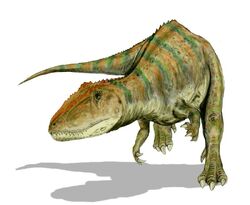 Artist's reconstruction of Carcharodontosaurus. | |
|
Classification |
Dinosaur; Theropod; Allosauroid; Carcharodontosaurid; Carcharodontosaurus |
|
Species |
|
|
Name Means |
Shark toothed lizard |
|
Pronunciation |
kar-KAR-oh-DON-to-SORE-uss |
|
Weight |
|
|
Height |
|
|
Length |
|
|
Timespan |
100-93 mya |
|
Location |
Africa |
|
Diet |
Carnivorous; hunter and scavenger |
Carcharodontosaurus, meaning Shark toothed lizard, was an enormous theropod dinosaur native to Africa 100 - 93 million years ago during the late Aptian to early Cemonian periods of the Cretaceous. Despite being poorly known, Carcharodontosaurus is likely the second-largest species of theropod dinosaur, larger than Tyrannosaurus and comparable in size of Giganotosaurus, but smaller than Spinosaurus. Two species of Carcharodontosaurus are currently known. C. saharicus is the type species and larger species, while C. iguidensis is smaller.
Discovery
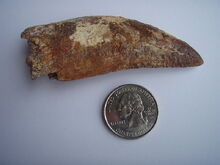
Carcharodontosaurus saharicus tooth.
Carcharodontosaurus fossils were first found by Charles Depéret and J. Savornin in the Continental intercalaire of Algeria (dating to the Albian stage) in 1927. Originally called Megalosaurus saharicus (many theropods were once erroneously referred to as Megalosaurus), its name was changed in 1931 by Ernst Stromer von Reichenbach to that used today. Stromer named Carcharodontosaurus "for its mainly Carcharodon-like teeth", which were "not recurved, almost bilaterally symmetrical but with convex edges."
Fossils
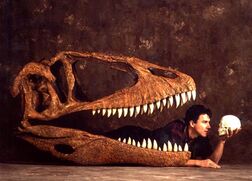
Paul Sereno next to a cast of a C.iguidensis skull
Very little is known about Carcharodontosaurus and Carcharodontosaurids in general. The Holotype of Carcharodontosaurus, discovered in 1912 by Stromer along with Spinosaurus. After describing Spinosaurus, he described another large Theropod which he dubbed 'Spinosaurus B'. It was not until the 1930's when more fragmentary remains, albeit sub-adult, was it realised this 'Spinosaurus B' was actually very different from Spinosaurus, and so Stromer re-named it (and Megalosaurus saharicus in the process) Carcharodontosaurus saharicus, meaning "Saharan shark-toothed reptile". Then in the late 1990's, Paul Sereno, in an expedition that yielded Suchomimus and new Sarcosuchus fossils, found some new large Carcharodontosaurid jaw fragments. These were formally described in 2007 and were dubbed Carcharodontosaurus iguidensis. C. saharicus is estimated to be between 12 and 13.5 m long. Although a study in 2007 claimed it was 13.2m. If C. iguidensis were in the same proportiones as C.saharicus who had a 1.6m skull, a C.iguidensis who has a 1.42m skull would be around 10m long and 4t in weight.
Description
Carcharodontosaurus was a massive predatory theropod dinosaur. Although its brain was not as large as those of tyrannosaurids and Giganotosaurus, Carcharodontosaurus was still obviously smart enough to plan hunting strategies. At first glance, Carcharodontosaurus seems to have many similarities to its relative, Allosaurus; however the two theropods are actually quite different (except for the fact that they are both allosauroids.)
Paleontologists have classified Carcharodontosaurus in its own family, the Carcharodontosauridae. Being the type genus, Carcharodontosaurus is obviously typical of the family. Its fossils consist mostly of fragmentary skulls. Reconstruction is based on Carcharodontosaurus' close relative, Giganotosaurus. Both massive theropods are carcharodontosaurids, in the allosaur group. Like Giganotosaurus, Carcharodontosaurus had a lightweight, porous skull with large fenestrae. It would have been a powerful hunter, with long front arms equipped with hook-like claws, and narrow jaws with teeth much like those of the great white shark. It would have been graceful, and elegant in design. Like many allosauroids, it also had a ridge above each of its eyes.
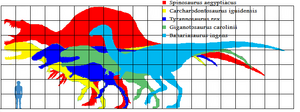
A scale chart showing C. iguidensis alongside other giant theropods, C. iguidensis in yellow.
Although poorly known, Carcharodontosaurus was most likely the second-largest predatory dinosaur ever, after Spinosaurus. C. sahiricus measured between 12 and 12.8 meters long and weighed in at around 5 to 6 tonnes. However, the larger C.iguidennis measured up to 14m long and weighed nearly 7t. Ever since its discovery it has been a contender for the title of largest Theropod. Its initial indetification led to massive hype, despite Tyrannosaurus was of a similar length but bulkier, and the seemingly forgotten Spinosaurus was bigger still at 14-15m at the time. Carcharodontosaurus fell out of the public view until Paul Sereno discovered some more fossils in the 1990's. But it was still largely ignored due to the Tyrannosaurus Rex 'Sue' and Giganotosaurus, despite the fact that Carcharodontosaurus was likely longer than Tyrannosaurus and comparable in size with Giganotosaurus. I twas not until C. iguidensis was described in 2007 that it was originally recognised as truly larger than Tyrannosaurus but after it was discovered that it was a bit smaller.
Species
Two species of Carcharodontosaurus are currently known: Carcharodontosaurus saharicus, the larger type species, and Carcharodontosaurus igiduensis which is smaller and lesser-known.
Carcharodontosaurus saharicus
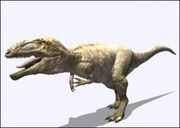
Life restoration of C. Saharicus
Carcharodontosaurus saharicus is the type and larger species, and much better-known than C. igiduensis. Its skull is less porous than that of Carcharodontosaurus igiduensis; this seems to indicate that its jaws would have been less flexible. It is likely that this was made up for by a stronger bite force. C. saharicus, although becoming well-known in popular culture, is larger and more powerful than traditionally depicted. This carnivore would have likely had a more powerful bite force than its slightly smaller cousin, Carcharodontosaurus igiduensis. When Carcharodontosaurus is mentioned, it is almost always referring to Carcharodontosaurus saharicus. This species was discovered by Charles Depéret and J. Savornin, in 1927. It averaged 12 metres (40 feet) in length, similar in size to large specimens of Allosaurus and average Giganotosaurus. Carcharodontosaurus saharicus' maximum size was probably around 13.5 metres (44.2 feet), rivalling better-known theropods such as Tyrannosaurus and Giganotosaurus in length.
Carcharodontosaurus igiduensis
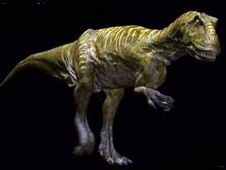
Life restoration of C. igiduensis
Unlike C. saharicus, Carcharodontosaurus igiduensis is a recently-discovered dinosaur. Its fossils are fragmentary, but based on them its skull seems to be more porous than that of Carcharodontosaurus saharicus. The dinosaur would have been a very large and deadly theropod. Igiduensis would have had scissor-shaped jaws, and the same teeth (albeit smaller) than C. saharicus, giving it the perfect weapon for slicing flesh. This massive theropod was only discovered in 2007, by Paul Sereno, and is very poorly known. However, it was even smaller than Carcharodontosaurus saharicus. C. igiduensis would have hunted the large ornithopods and perhaps even sauropods that inhabited its region. It would have reached 4 tonnes, and 10 metres in length.